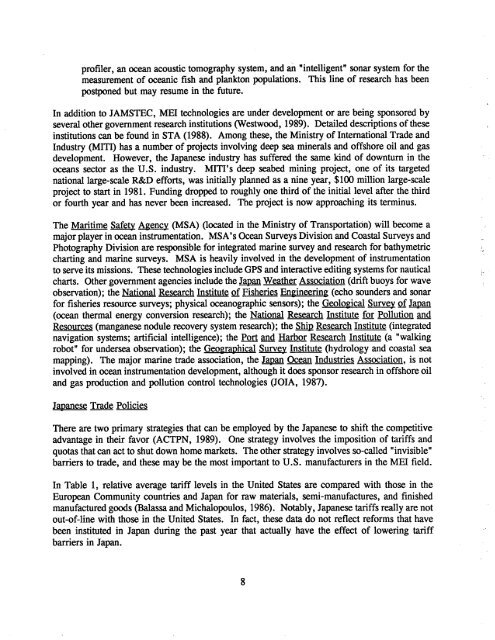WHOI-90-52
WHOI-90-52
WHOI-90-52
Create successful ePaper yourself
Turn your PDF publications into a flip-book with our unique Google optimized e-Paper software.
profier, an ocea acoustic tomography system, and aD "intellgent" sonar system for the<br />
measurement of ocic fish and plankton populations. This line of resech has been<br />
postpned but may resume in the future.<br />
In addition to JAMSTEC, MEI technologies are under development or are being sponsored by<br />
several other government resech institutions (Westwoo, 1989). Detaled descriptions of<br />
these<br />
institutions ca be found in ST A (1988). Among these, the Ministry of International Trade and<br />
Industry (Mm) has a number of projects involving deep se minerals and offshore oil and gas<br />
development. However, the Japanese industr has suffered the same kind of downturn in the<br />
ocs setor as the U.S. industr. MITI's deep sebed mining project, one of its tageted<br />
national large-scae R&D efforts, was initially planned as a nine yea, $100 milion large-scale<br />
project to sta in 1981. Funding droppe to roughly one third of the initial<br />
level after the third<br />
or fourth yea and has never been increase. The project is now approaching its terminus.<br />
The Martime Safety Agency (MSA) (locted in the Ministr of Transporttion) wil become a<br />
major player in ocea instrmentation. MSA's Oc Surveys Division and Coasta Surveys and<br />
Photography Division are responsible for integrated marne survey and reseach for bathymetric<br />
charng and marne surveys. MSA is heavily involved in the development of instrmentation<br />
to serve its missions. These technologies include GPS and interactive editing systems for nautical<br />
chars. Other government agencies include the Japan Weather Association (drift buoys for wave<br />
observation); the National Reseach Institute of Fisheries Engineering (echo sounders and sonar<br />
for fisheries resource surveys; physica oceaographic sensors); the Geological Survey QÍ Japan<br />
(ocea thermal energy conversion reseach); the National Reseach Institute for Pollution and<br />
Resources (manganese nodule recovery system reseach); the Ship Reseach Institute (integrated<br />
navigation systems; arificial intellgence); the Port and Harbor Reseach Institute (a "walking<br />
robot" for underse observation); the Geographical Survey Institute (hydrology and coasta se<br />
mapping). The major marne trade association, the Japan Oc Industries Association, is not<br />
involved in oc instrmentation development, although it does sponsor reseach in offshore oil<br />
and gas production and pollution control technologies (JOIA, 1987).<br />
Japanese Trade Policies<br />
There are two primar strategies that ca be employed by the Japanese to shift the competitive<br />
advantage in their favor (ACTPN, 1989). One strategy involves the imposition of taffs and<br />
quotas that ca act to shut down home markets. The other strategy involves so-called "invisible"<br />
barers to trde, and these may be the most importt to U.S. manufacturers in the MEI field.<br />
In Table i, relative average taff levels in the United States are compared with those in the<br />
Europe Community countres and Japan for raw materials, semi-manufactures, and finished<br />
manufactured goos (Balassa and Michalopoulos, 1986). Notably, Japanese taffs realy are not<br />
out-of-line with those in the United States. In fact, these data do not reflect reforms that have<br />
been instituted in Japan during the past yea that actually have the effect of lowering taff<br />
barers in Japan.<br />
8
















